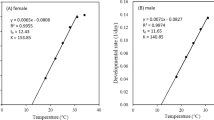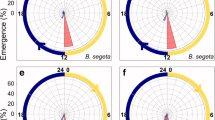Abstract
The adult emergence rhythm of Telenomus busseolae, an egg parasitoid of Sesamia nonagrioides, was examined when parasitoids were exposed to different light-dark regimes. Most of the adult parasitoids emerged throughout the whole period of the photoperiodic cycle. Peak male emergence occurred 2–5 hours earlier than that of females. Adult emergence was asynchronous in continuous darkness or light. However, regimes of alternative light and dark phases such as L4:D20, L8:D16, L12:D12, L16:D8 and L20:D4 h generated a population rhythm with a period length of 24 hours. The peak of the emergence activity moves from the scotophase to the middle of the photophase with an increase of the photophase from 4 to 20 h. Rhythmical activity of adults was synchronised within 2 cycles when immature stages of parasitoid grow under continuous light conditions (LL) and then transferred to L12:D12. Moreover, emergence rhythm persisted and continued in a free-run with a period length of less than 24 hours by transferring a rhythmic culture from L12:D12 h to LL or RR (continuous red light) conditions, indicating the existence of a circadian rhythm. The ecological implications of the expression rhythm relate to better survival of the parasitoids.
Similar content being viewed by others
References
Alexandri, M.P. and J.A. Tsitsipis, 1990. Influence of the egg parasitoid Platytelenomus busseolae(Hym.: Scelionidae) on the population of Sesamia nonagrioides(Lep.: Noctuidae) in central Greece. Entomophaga35: 61-70.
Baniabbassi, N., 1981. News. Entomology Newsletter, Int. Soc. Sugarcane Tech.10: 2.
Beck, S.D., 1980. Insect photoperiodism, 2nd ed. Academic, New York.
Bin, F. and N.F. Johnson, 1982. Potential of Telenominaein biocontrol with egg parasitoids (Hym.: Scelionidae). Les Trichogrammes, Les Colloques de l'INRA9: 275-287.
Bosque-Perez, N.A., J.A. Ubeku and A. Polaszek, 1994. Survey for parasites of Sesamia calamistis(Lep.: Noctuidae) and Eldana saccharina(Lep.: Pyralidae) in southwestern Nigeria. Entomophaga39: 367-376.
Corrigan, J.E., J.E. Laing and J.S. Zubricky, 1995. Effects of parasitoid to host ratio and time of day of parasitism on development and emergence of Trichogramma minutum(Hymenoptera: Trichogrammatidae) parasitizing eggs of Ephestia kuehniella(Lepidoptera: Pyralidae). Ann. Entomol. Soc. Am.88: 773-780.
Daan, S., 1981. Adaptive daily strategies in behaviour. In: J. Aschoff (ed), Handbook of behavioral neurobiology, Vol. 4: Biological rhythms. Plenum Press, London and New York. pp. 275-298.
Doutt, R.L., 1964. Biological characteristics of entomophagus adults. In: P. DeBach (ed), Biological control of insect pests and weeds. Chapman and Hall, London. pp. 145-167.
Fagerstrom, T. and C. Wiklund, 1982. Why do males emerge before females? Protandry as a mating system strategy in male and female butterflies. Oecologia52: 164-166.
Fantinou, A.A., M.G Karandinos and J.A. Tsitsipis, 1995. Diapause induction in the Sesamia nonagrioides(Lepidoptera: Noctuidae) effect of photoperiod and temperature. Environ. Entomol.24: 1458-1466.
Hafez, M., A.H. El-kifl and Y.H. Fayad, 1977. On the bioconomics of Platytelenomus hylasNixon, an egg parasite of Sesamia creticaLed. in Egypt. Bull. Soc. Entomol. Egypt61: 161-178.
Harris, K.M., 1962. Lepidopterous stem borers of cereals in Nigeria. Bull. Entomol. Res.53: 139-171.
Laudonia, S., G. Viggiani and G. Rotundo, 1991. Dati morpho-biologici sul Telenomus busseolaeGahan (Hymenoptera: Scelionidae) ooparassitoide di Sesamia nonagrioides(Lefebvre) (Lepidoptera: Noctuidae) introdotto in Italia. Boll. Lab. Ent. agr. Filippo Silvestri48: 125-136.
Leyenaar, P. and R.B. Hunter, 1977. Effect of stem borer damage on yield in the coastal savanna zone in Ghana. Ghana J. of Agr. Sci.10: 67-70.
Melamed-Madjar, V. and J. Tam, 1980. A field survey of changes in the composition of corn borer populations in Israel. Phytoparasitica8: 201-204.
Moutia, L.A. and C.M. Courtois, 1952. Parasites of the moth borers of the sugarcane in Mauritius. Bull. Entomol. Res.43: 325-359.
Nadel, H. and R.F. Luck, 1992. Dispersal and mating structure of a parasitoid with a female-biased sex ratio: implications for theory. Evol. Ecol.6: 270-278.
Nucifora, A., 1966. Appunti sulla biologia di Sesamia nonagrioides(Lef.) in Sicilia. Tec. Agr.XVIII: 395-419.
Polaszek, A., J.A. Ubeku and N.A. Bosque-Perez, 1993. Taxonomy of the Telenomus busseolaespecies-complex (Hymenoptera: Scelionidae) egg parasitoids of cereal stem borers (Lepidoptera: Noctuidae, Pyralidae). Bull. Entomol. Res.83: 221-226.
Polaszek, A. and S.W. Kimani, 1990. Telenomusspecies (Hymenoptera: Scelionidae) attacking eggs of pyralid pests (Lepidoptera) in Africa: a review and guide to identification. Bull. Entomol. Res.80: 57-71.
Rounbehler, M.D. and J.J. Ellington, 1973. Some biological effects of selected light regimes on Trichogramma semifumatum(Hymenoptera: Trichogrammatidae). Ann. Entomol. Soc. Amer.66: 6-10.
Saunders, D.S., 1982. Insect clocks, 2nd ed., Pergamon Press, Oxford.
Setamou, M. and F. Schulthess, 1995. The influence of egg parasitoids belonging to the Telenomus busseolae(Hymenoptera: Scelionidae) species complex on Sesamia calamistis(Lepidoptera: Noctuidae) populations in maize fields in southwestern Benin. Biocontrol Sci. and Technol.5: 69-81.
Statistical Graphics, 1991. Statgrafics, version 5. Statistical Graphics, Rockville, MD.
Tsitsipis, J.A., 1990. Contribution toward the development of an integrated control method for the corn stalk borer, Sesamia nonagrioides(Lef.) In: J.E. Casida (ed), Pesticides and alternatives, Elsevier/Amsterdam. pp. 217-228.
Tsitsipis, J.A., B.E. Mazomenos and M. Alexandri, 1987. The corn stalk borer, Sesamia nonagrioides: bioecology and control prospects. In: ANPP (Association Nationale de Protection des Plantes) (ed), Proceedings of International Conference on Pests in Agriculture, Paris, No. 6, Vol. II, 1987, pp. 271-278.
van Lenteren, J.C., P. Szabo and P.W.T. Huisman, 1992. The parasite-host relationship between Encarsia formosaGahan (Hymenoptera, Aphelinidae) and Trialeurodes vaporarium(Westwood) (Homoptera, Aleyrodidae) XXXVII. Adult emergence and initial dispersal pattern of E. formosa. J. Appl. Entomol.114: 392-399.
Waage, J.K., 1982. Sib-mating and sex-ratio in scelionid wasps. Ecol. Entomol.7: 103-112.
Waage, J.K. and S.M. Ng, 1984. The reproductive strategy of a parasitic wasp. I. Optimal progeny and sex allocation in Trichogramma evanescens. J. Anim. Ecol.53: 401-415.
Werren, J.H., 1980. Sex ratio adaptations to local mate competition in a parasitic wasp. Science208: 1157-1159.
Wiklund, C. and T. Fagerstrom, 1977. Why do males emerge before females? A hypothesis to explain the incidence of protandry in butterflies. Oecologia31: 153-158.
Author information
Authors and Affiliations
Rights and permissions
About this article
Cite this article
Fantinou, A., Alexandri, M. & Tsitsipis, J. Adult emergence rhythm of the egg-parasitoid Telenomus busseolae. BioControl 43, 141–151 (1998). https://doi.org/10.1023/A:1009984318289
Issue Date:
DOI: https://doi.org/10.1023/A:1009984318289




